Mudra is one of many stainless steel sculptures in Toronto by artist Ted Bieler, also the creator of Triad on Front Street West and other sculptures around Toronto and beyond. This impressive structure can be found in front of the official office of the Government of Ontario, espousing the large concrete building, with its long steel poles reaching to the heights.
Downtown Yonge Artwalk
Artwalks
Steel
More than 12 million metric tons of steel is produced in Canada yearly. Steel is also a medium of choice for public artworks. It is also a chameleon material! Here is a route that will walk you through different looks and feels of steel!
Mudra
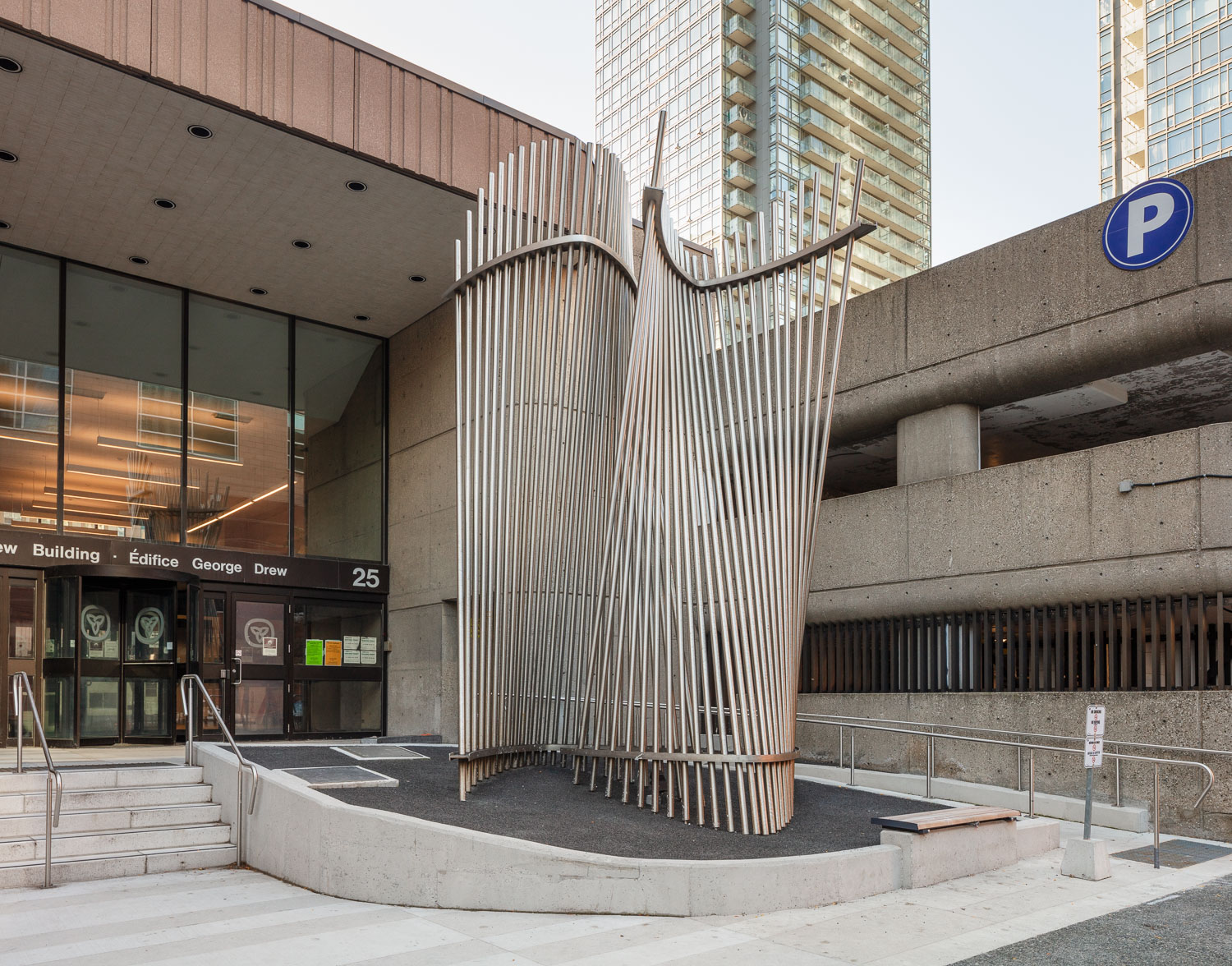
- Stainless Steel
- 1974
- 25 Grosvenor Street, Toronto
About the artwork
About the artist
Ted Bieler, sculptor and Professor of Fine Art at York University, is the creator of many privately owned and public sculptures, including: Triad on Front Street in Toronto, Canyons at the TTC Wilson Station, Toronto, Tetra in Portsmouth Harbour, Kingston and Wave Breaking at the Canadian Embassy in Tokyo, Japan. Born in Kingston in 1938, he studied art at Cranbrook Academy of Art, and has been teaching, exhibiting, and making public sculpture since graduating. His interest in metal casting processes has led him to experiment with new technologies in his own sculpture.
Fun facts
- Ted Bieler is one prominent Canadian artist who was exhibited during Expo 67 in Montreal, during which Canada celebrated its centennial.
Engagement questions
- How does this work connect to our contemporary vision of sculptural art?
- How do you engage with the specific steel shapes of Bieler’s work?
Communications
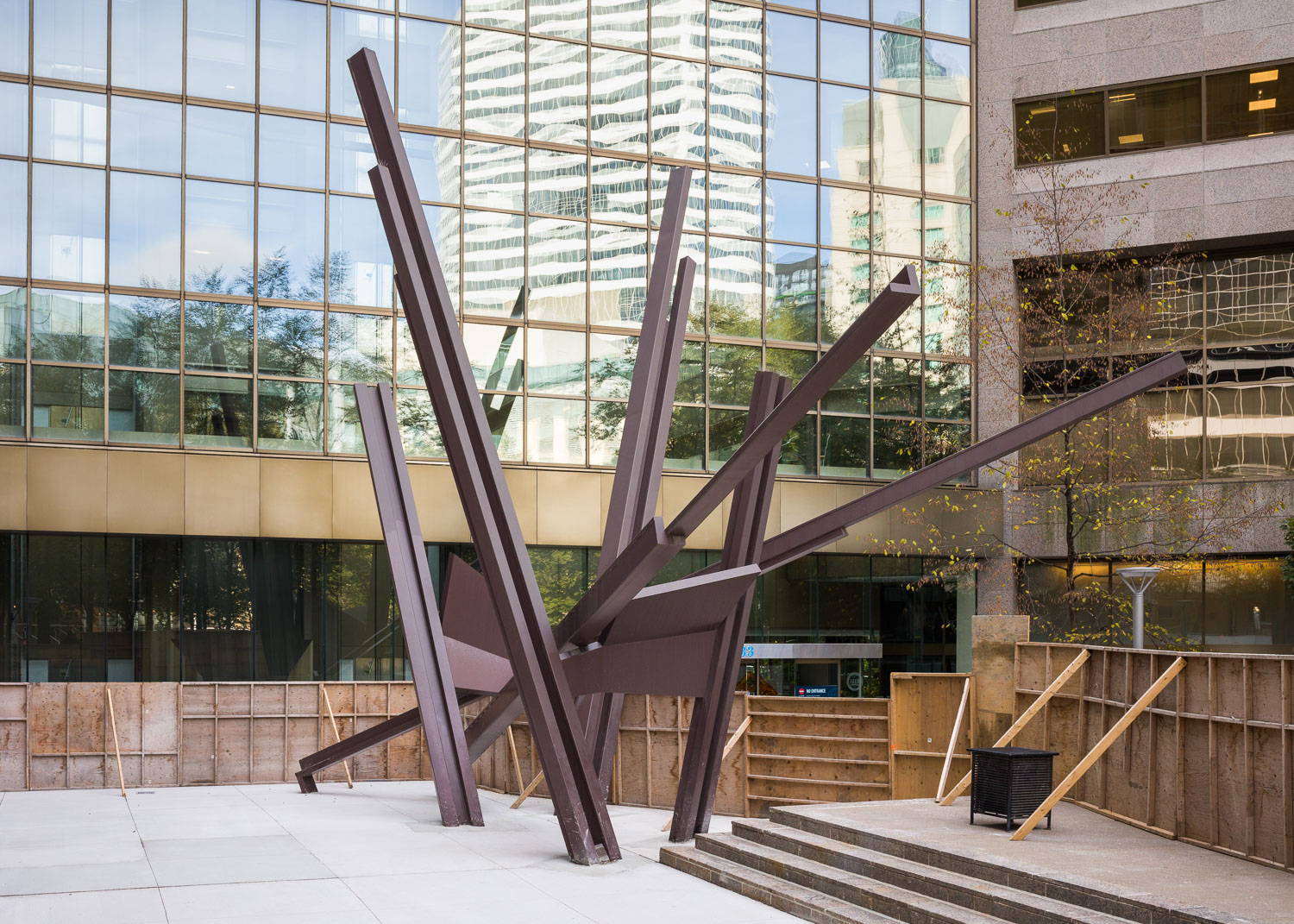
- Steel
- 1983
- 483 Bay Street, Toronto
About the artwork
This constructivist sculpture also known as Space Composition for Trinity Square, is located at the southwest corner of Trinity Square, on the west side of the Eaton Centre. The sculpture plays an important role for Toronto’s public art scene, at the edge of monumentalism and brutalism, it creates a heavy contrast between the various materials of the structure and the surrounding environment. The reflection of steel on the facade of the building plays with the daily variations of the sun, recreating the shadows of Toronto’s downtown.
About the artist
Haydn Llewellyn Davies was born in Rhymney, Wales, in 1921. A Canadian resident since 1929, Davies’ unique mix of Welsh tradition and landscape feature prominently in his work. He studied painting and drawing at the Ontario College of Art and later, sculpture at the University of Toronto.
Although Davies’ first career was in advertising, he left the field in the 1970s. He won his first public sculpture commission in 1974 from Lambton College in Sarnia, Ontario. The resulting work, Homage, made from Western Red Cedar, was Davies’ first large-scale public sculpture. Subsequent large-scale works in steel or aluminum are located at the entrances of the Vero Beach Art Museum, Florida, the Government of Ontario Offices, in Windsor, Ontario, the Burlington Art Centre, Ontario, the Bell Canada Head Office, Toronto, and the Windsor Sculpture Garden.
In Europe, his works are in the permanent collections of the Galleria Nazionale D’Arte Moderna e Contemporenea, Rome, Italy, Museo d’Arte Moderna, Venice, Italy, the Musées Royaux des Beaux-Arts de Belgique, Brussels.
A poster done by Davies during his WW2 service in the RCAF is in the Permanent Poster Collection of the Victoria and Albert Museum in London. Davies passed away in Toronto in 2008.
Fun facts
- This constructivist sculpture is also known as "Space Composition for Trinity Square".
Engagement questions
- How does this work by Davies make you feel?
- Why do you think this material was chosen for this piece?
Light Spirals
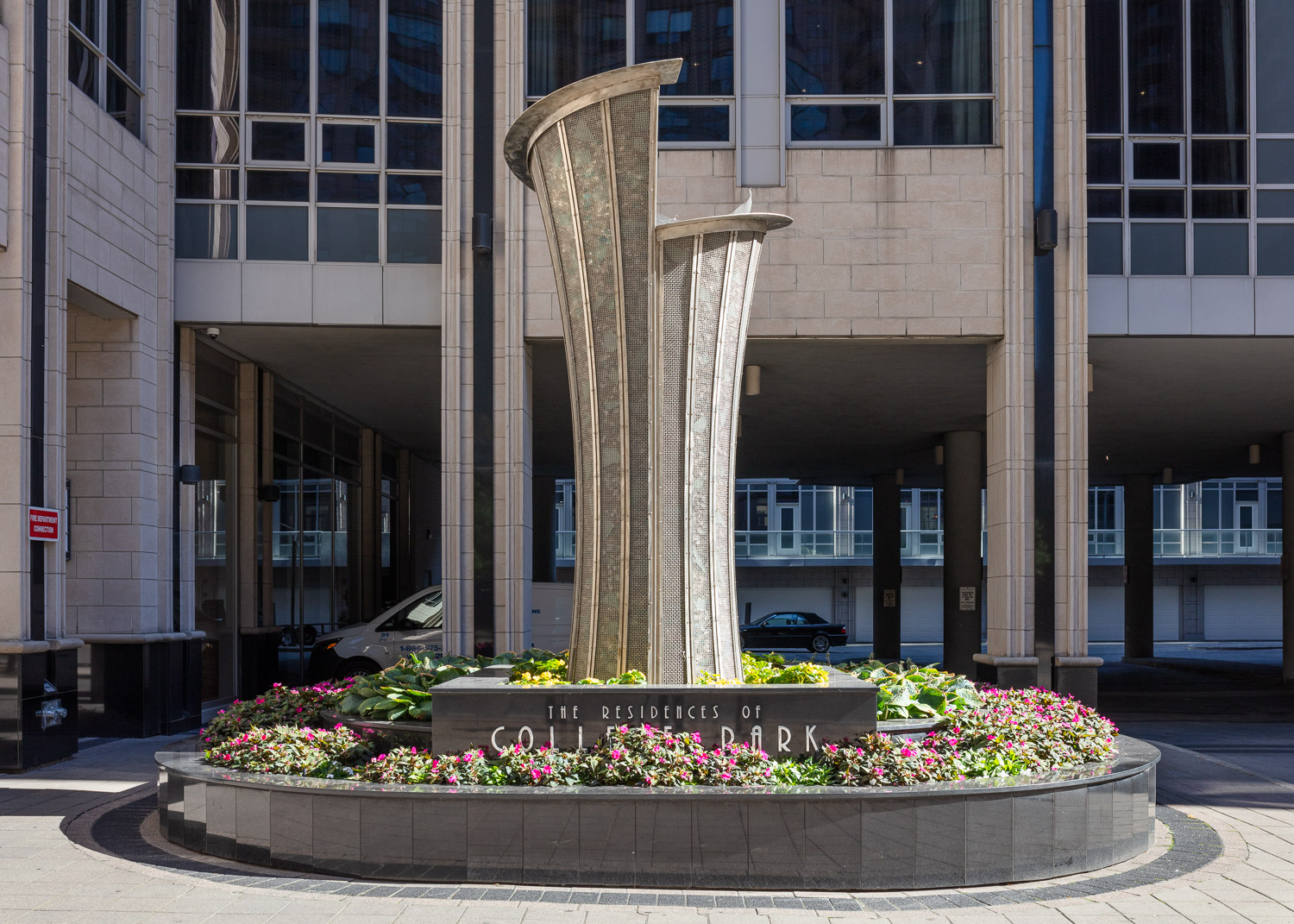
- Stainless steel, recycled glass, digital LED array
- 2006
- 761 Bay Street, Toronto
About the artwork
The artwork is set in granite bases to give the sculptures an elevated effect, as well as three other important components: the form, which is a stainless steel mesh exterior, the glass which lies within the mesh and the digitally-controlled lighting. Even though the two pieces look alike, slight differences are to be seen, creating a visual effect, where the lighting recreates an elegant vessel around the spiral shaped pieces.
About the artist
Since 1970, Peter Powning has lived and worked as an artist in the hills of southern New Brunswick. His life is characterized by intense periods of work preparing for exhibitions and commissions, punctuated by periodic travel. While Powning’s award-winning work is shown internationally, it is permeated with qualities distilled from a life lived close to the silence, space and seasonal rhythms of his home, the fields, forests and shorelines of Canada’s east coast.
Fun facts
- As part of this commission, the developers suggested that when the second tower of the ongoing real estate project is completed, the artist could unveil a second sculpture and pair with the already existing one, mirroring two reverse spirals.
Engagement questions
- In the 70s, futurism was part of contemporary pop-culture. How do you envision futurism today in our 21st century society?
- Do you feel comfortable with light artworks? How can cities best save their energy resources?
Victoria Lane Murals
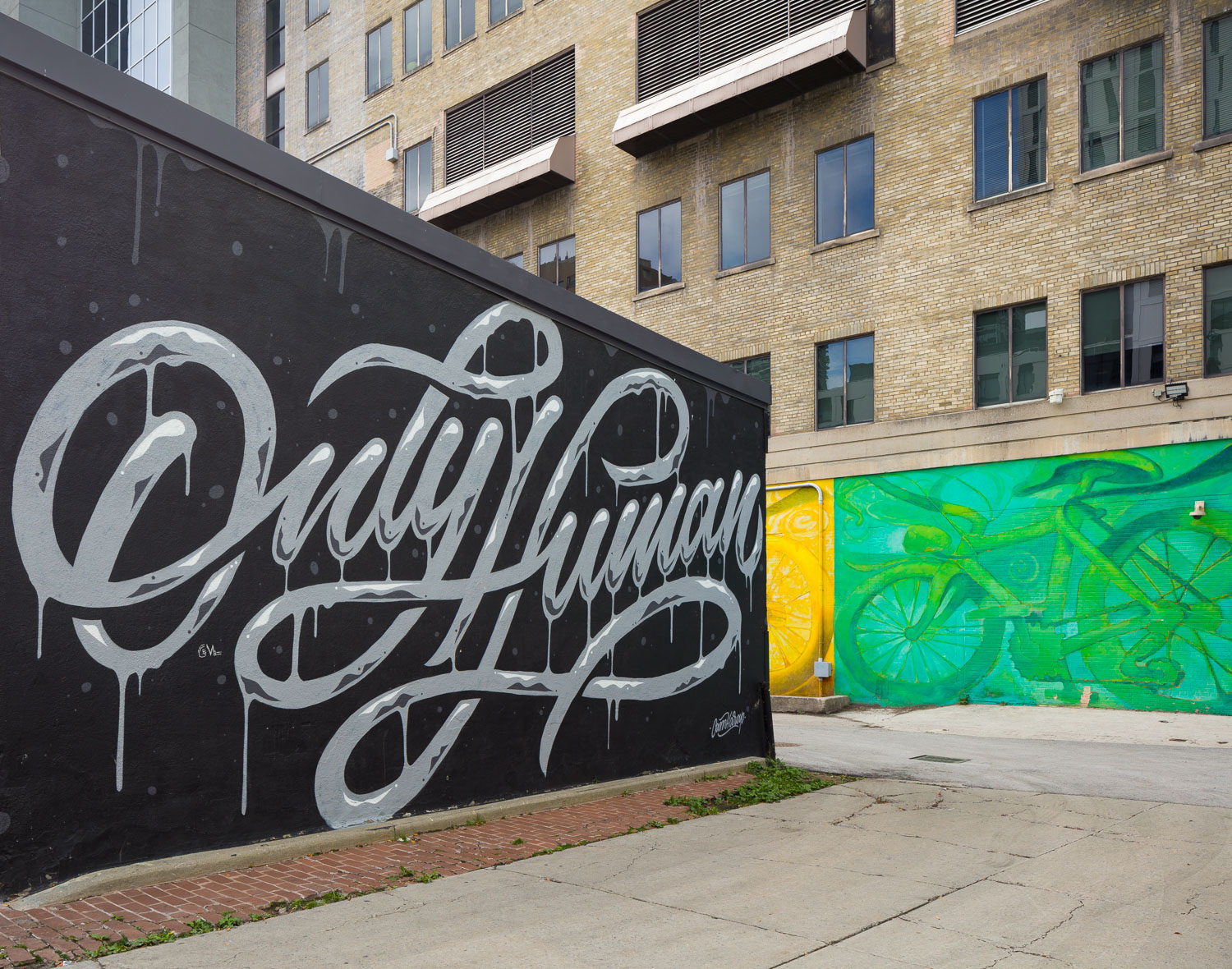
- Spray Paint
- 2019
- 38 Dundas Street East (and behind Ryerson at the Church on Victoria Street Lane), Toronto
About the artwork
Kadence and Sony Music Entertainment Canada in partnership with Downtown Yonge BIA, in support of arts & culture as part of their music strategy, collaborated together to revitalize a neglected alley in the city with the Alley Jams event: “Reviving alleyways with street-culture.”
As seen from Yonge Dundas Square, the left side of the northeast corner of Dundas and Victoria was painted by Emily May Rose. The other side features a mural by OneDay Creative Agency as a tribute to the top trending artists from the Toronto scene right now.
About the artist
Emily May Rose is an award-winning artist and illustrator based in Toronto. Inspired by her own experiences, Emily’s work features a cast of recurring characters (most notably her pot-smoking, pizza-eating raccoons) to depict humorous situations that are relatable to many of us who are trying to survive in an urban environment.
Her work can be found in many formats including murals, editorial illustration, apparel design, installations, and gallery settings. Her murals can be found all over the world where she’s painted in street art festivals, artist residencies, and other commissions during her various travels.
In February of 2016, Emily opened Northern Contemporary in Toronto. The space has since grown to take over the historic Parkdale Theatre building, and is home to an art gallery, event space, and a 30 person studio collective, that she works out of herself. Northern Contemporary hosts all kinds of exhibitions, events, launches, and markets, with a heavy focus on illustration, urban, pop art, and experimental work.
One Day Creative was founded to provide creative and unique solutions and help clients and patrons to bring their artistic and visual ideas to reality. They offer a variety of artistic practices such as custom mural painting, video production, sign painting, logo design, and more. From the drawing board to project execution, they can cover every corner of an artistic undertaking.
Fun facts
- The artist’s trademark: The Racoon. Why? Because racoons are amazing. In collaboration with the AGO, Emily led an interactive art making activity to create raccoon masks and shadow puppet raccoons.
Engagement questions
- Do you think street art can revitalize an entire neighbourhood?
- Would you like to engage in community wall spray paintings?
Toronto Hydro Fence
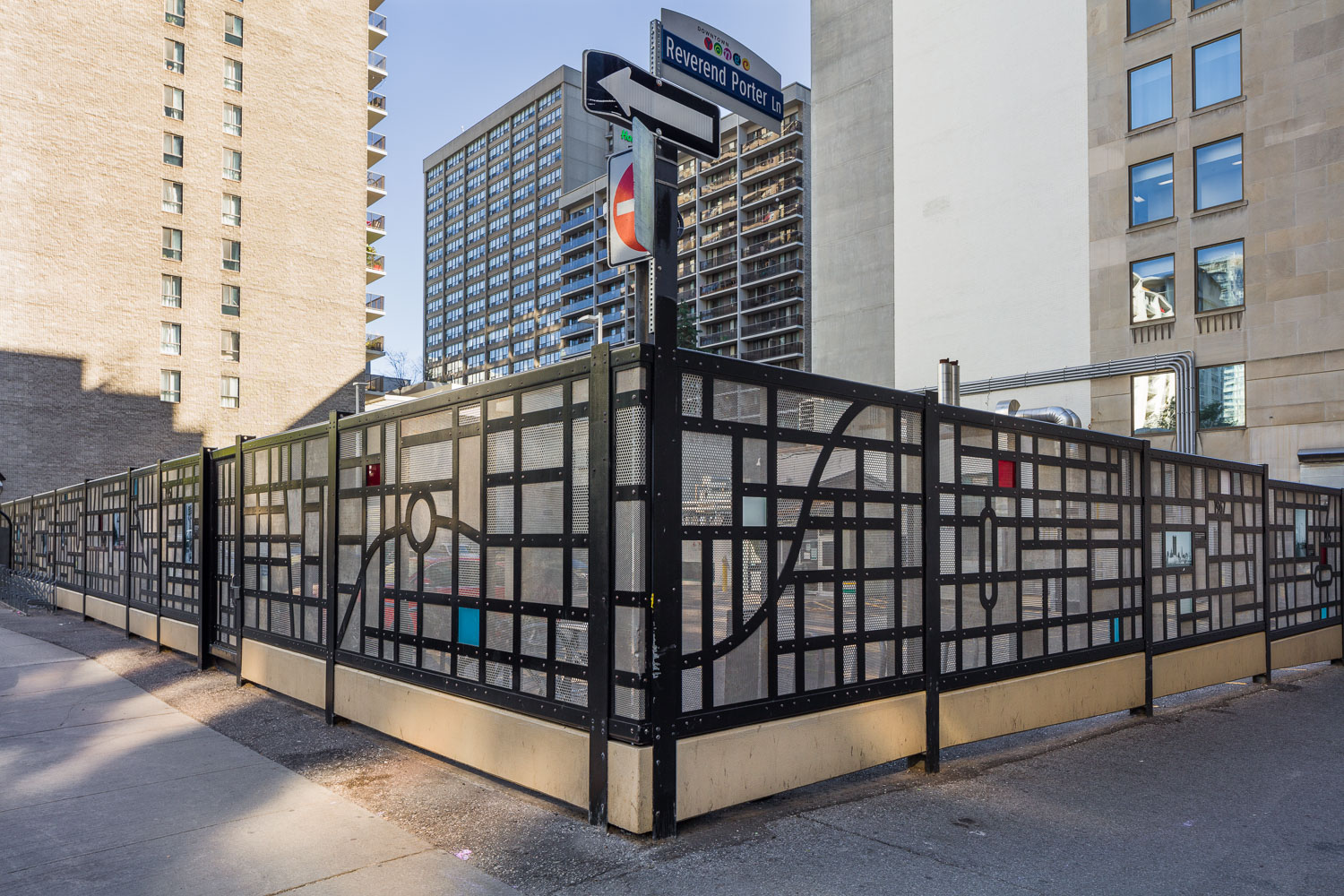
- Steel
- 2016
- 14 Carlton Street, Toronto
About the artwork
IPM was approached by Toronto Hydro, in collaboration with the Downtown Yonge BIA, to coordinate the provision of a secure parking area for staff at their historical location at 14 Carlton Street. Toronto Hydro wanted an enclosure that was a piece of art and a feast for the eyes while serving the dual purpose of chronicling the 100+ year history of this prestigious corporation.
About the artist
Independent Project Managers (IPM) is not a design or construction contractor and has no affiliations with any construction manager, general contractor, trade contractor or union organization.
The company was formed to serve the industry as a project management company so that clients could take advantage of the services being offered exclusively for their benefit, with no conflict being introduced that would favour any particular contractor or trade.
Fun facts
- The fence was custom-designed, custom-built and required unique steel fabrication techniques and lighting to highlight the numerous historical photos of the Toronto Hydro’s long history embedded into the fence design.
Engagement questions
- How do you think art is beneficial in telling history?
- How do you feel standing in front of this piece?
Flow Blue

- Stainless Steel, LED Lights, Resin
- 2008
- 26 Granby St
About the artwork
Flow Blue is a Toronto Public Art Commission for Edilcan Corporation, sited on Carlton and Granby Streets in Toronto. The tree motif was inspired by the historic tree-lined Granby Street that forms part of this site.
An avenue of trees, seventeen feet in height, lines an Archway that joins Granby to Carlton. This avenue of trees accentuates the historic use of the path through the Archway, yet emphasizes the urban context by replacing the natural tree colour with electric-blue auto body paint. By night the vault of the Archway is illuminated with blue LED lights, simulating the sky.
Three hundred feet of stainless steel fence system, laser-cut in a flowing tree-branch design, lines the gentrified townhouses of the Granby Street area. Blue LED lights illuminate this fence at night, continuing the flow of blue and accentuating the tree-branch design.
About the artist
Marlene Hilton-Moore is a self-taught artist born in New Brunswick and living in Ontario. Her work is in numerous collections, including the Canada Council for the Arts’ Art Bank and the Wilfrid Laurier University collection. She has also produced a number of works of public art, including Monument aux Valeureux in Ottawa and Column of Valour, a monument dedicated to volunteer firefighters in Barrie, Ontario.
Fun facts
- The tree motif was inspired by the historic tree-lined Granby Street that forms part of this site.
Engagement questions
- Can art replace the beauty of nature?
- How do you feel when you see trees made out of steel?
Safe Water
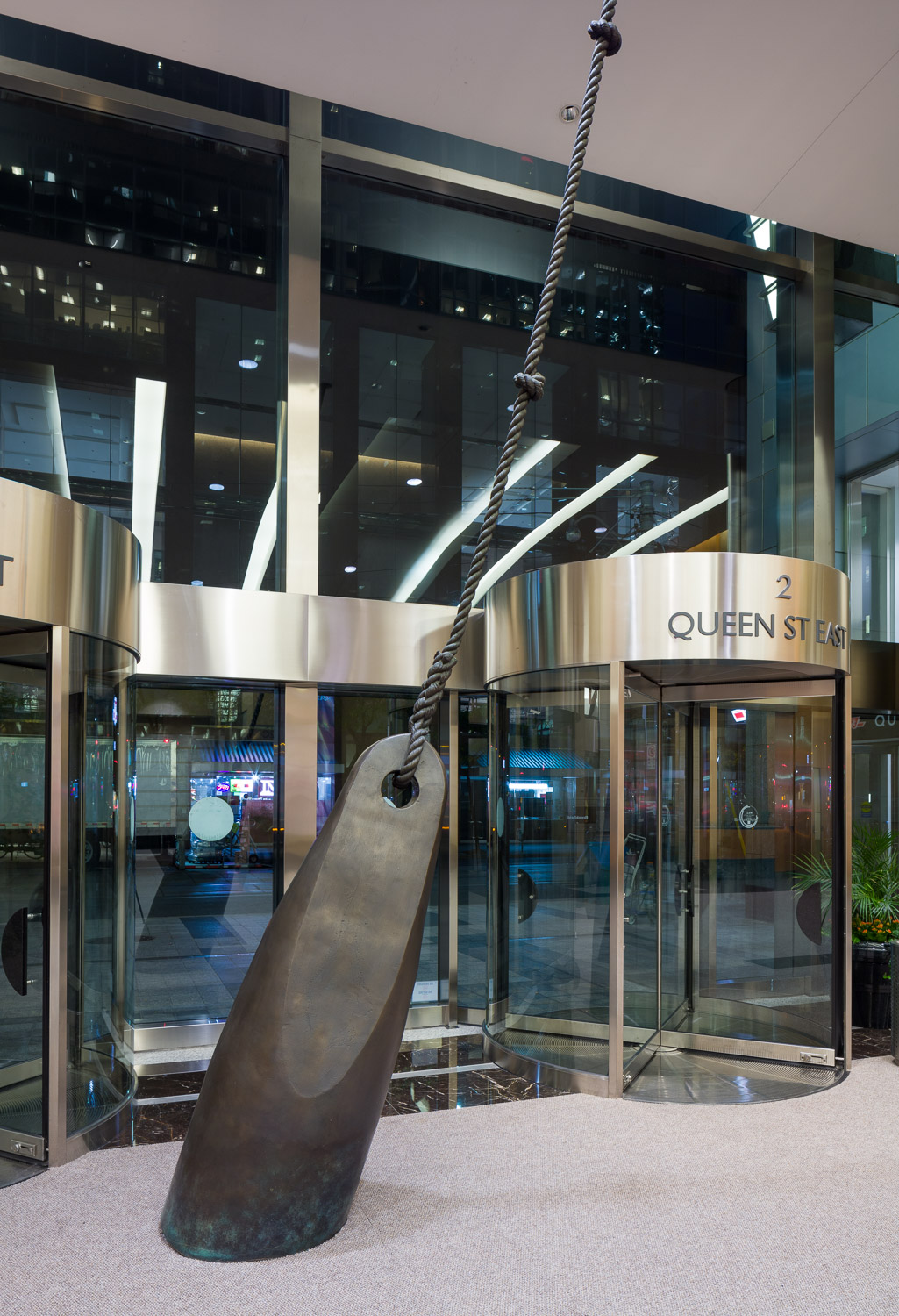
- Steel
- 2002
- 2 Queen Street East, Toronto
About the artwork
The lead line is a weighted rope, knotted or marked, used by seamen to measure the depth of the water. Historically, safe water, or “Mark Twain”, was two fathorns. We have implied by the knotted rope and the modification in scale that this site marks “safe water”.
About the artist
In 1972, Colette Whiten graduated from the Ontario College of Art and Design, receiving the Governor General’s Medal in recognition of her fine work. In the same year, she exhibited her first cast piece: a wooden structure filled with fibreglass molds of her friends’ arms and legs. Whiten’s figures express the nature of human existence and are primarily concerned with human interaction, particularly power relationships. The artist is also fascinated with the process of art, often documenting her creative flow through photographs and slides.
Over the years, the focus of Whiten’s practice and subject matter has evolved to include explorations into identity and the duality inherent in cast images, the nature of the art object and art making, and political power or everyday violence. Whiten’s larger scale, sculptural pieces have taken years to make as their many intricate pieces are constructed mainly by hand.
Whiten’s public art commissions include a wall construction with figurative cutouts for the Mental Health Centre, Toronto (1978), an award-winning sculpture for the 1988 Calgary Olympics, Weathervanes for Bankers Hall, Calgary (1990-91), and Tender, at the Worker’s Compensation Office, Simcoe Place, Toronto (1994-95.) Both Weathervanes and Tender were collaborations with Paul Kipps, Whiten’s beloved partner.
Between teaching at York University and the Ontario College of Art and Design, Whiten’s work has been featured in both solo and group exhibitions around the world. In 1991, she was the recipient of the Toronto Arts Foundation’s Visual Arts Award and in 2013, she was awarded a Governor General’s Award in Visual and Media Arts.
Upon earning his BA in Visual Art from the University of Western Ontario, Paul Kipps focused his artistic practice in the realm of sculpture. His works were driven by his interest in alienation, shaped by the often exclusive nature of cultural backgrounds, age, gender, class, or place. Kipps explored these concerns through the making of sound, photography, and three-dimensional structures.
Kipps’ work was exhibited in both Canada and Europe, and has been presented across Canada through a number of collaborative public art commissions with his partner, Colette Whiten. Kipps taught for many years, offered his distinct eye in curating, and continued to create up until his death in 2014.
Fun facts
- For an exhibition with Whiten called Over Taking Over, Paul Kipps brought his concept of a "garden of sound" to life. As a way of coping with his widowed mother's dementia, Kipps began documenting the impact of her condition on his own life, creating soundtracks out of her garbled phone calls and pairing them with sixteen gramophone-like wooden cones.
Engagement questions
- How does this work interact with the environment around it? Does the space amplify or benefit the artwork?
Quatro
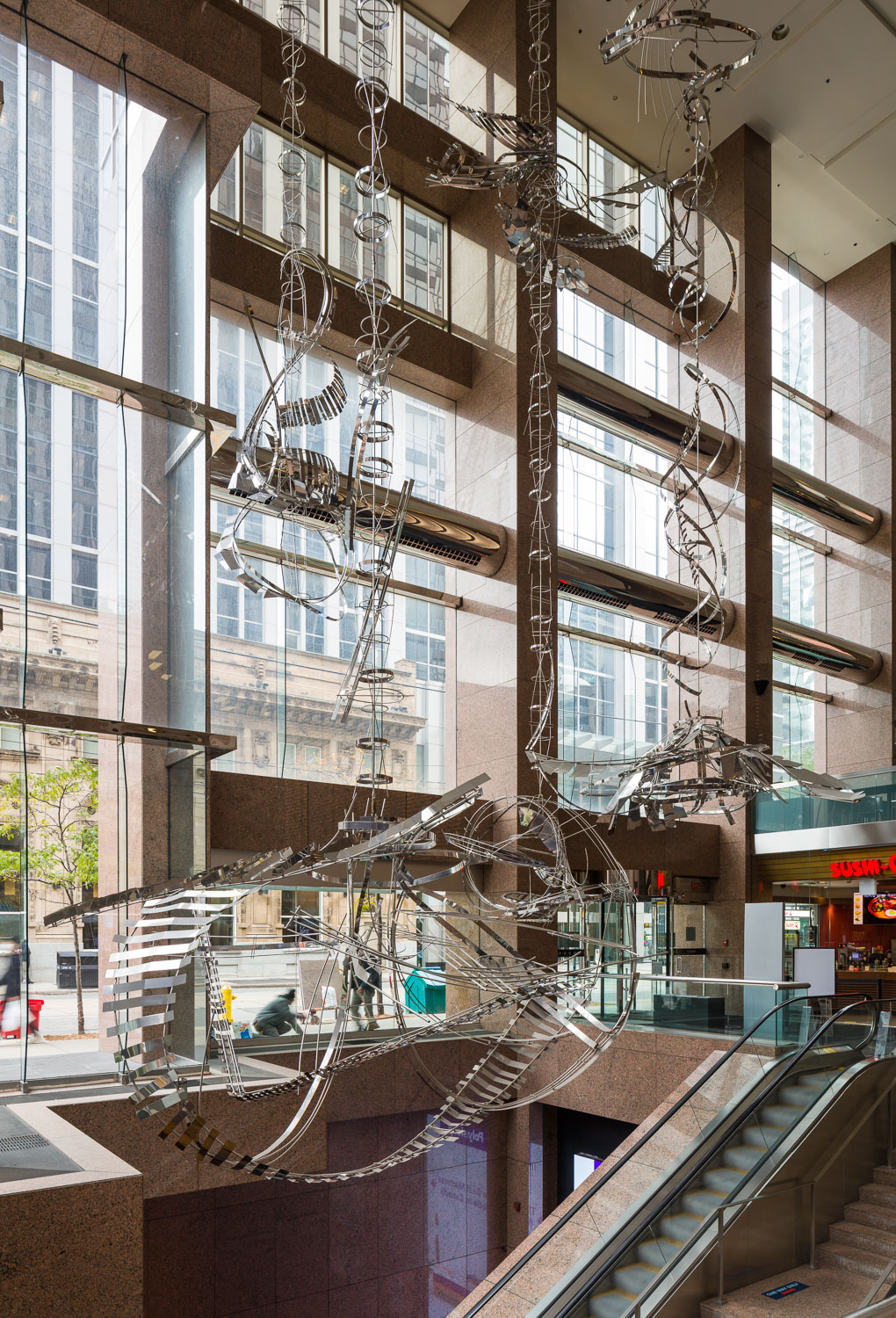
- Stainless steel
- 1991
- 1 Queen Street East, Toronto
About the artwork
Little is known about the piece Quatro but what is known is that Martin passionately believed art should not belong only in art galleries and museums, or the private collections of the few who could afford it. Long before Toronto’s Percent For Public Art Program (an official plan to encourage the inclusion of public art in all significant private sector developments across the city) became an important part of the contemporary art scene, Martin believed art should be accessible to all.
In 1956 he wrote, “Art must be an accepted part of everyone’s environment where it can teach and lend beauty and pleasure to everyday life.” Almost all of his major works have been permanently installed in public places.
About the artist
As a child, Artist and engineer Bill Martin knew he wanted to be an artist, but was encouraged to study something that would guarantee him a good living, so he studied chemical engineering at Case Institute of Technology. After Pearl Harbor, Martin enlisted in the Navy where he was trained to be an electronic technician. After the war he earned a degree in industrial engineering at Ohio State University.
Bored with his first job as an engineer, he finally committed to being an artist and enrolled at the Boston Museum School. In order to support his art and his growing family, he took a job in Cambridge where he was recruited to be a member of their “Invention/Design Team” — a select group of seven creative people with diverse backgrounds. During this time he collaborated with architects and interior designers and designed and made unique fountains and lighting for churches and temples, private residences and commercial spaces.
Martin ingeniously created the lighting for five interior stairways of the new National Arts Center in Ottawa where he cleverly invented a way to attach blocks of dalle glass to lines and branches of suspended steel cable. The installation, titled Crystal DNA, includes five hanging glass and steel sculptures ranging in size from 5 feet in diameter by 25 feet long to 6 feet in diameter by 85 feet long. Collectively the five sculptures have over 6,000 hunks of glass each attached to the helical structures by hand. All this was done not only while keeping his day job as an industrial designer, but also while teaching part-time at the Boston Museum School and working as an adjunct professor at Boston.
The Ottawa commission led to many additional major sculptural installations in such public places as lobbies, performance centers, airports and schools in Dallas, Maine, Colorado and Toronto. In his final years, Martin began to write as well and had recently begun a novel based on some of his life experiences. He passed away on June 29, 2012, in Brunswick.
Fun facts
- While serving in the Pacific Theatre, Bill Martin’s ship, the USS Isherwood, was struck by a kamikaze suicide pilot, killing many of the crew.
Engagement questions
- What words help to describe this artwork?
- How do you define a successful public art project?
Our Nell
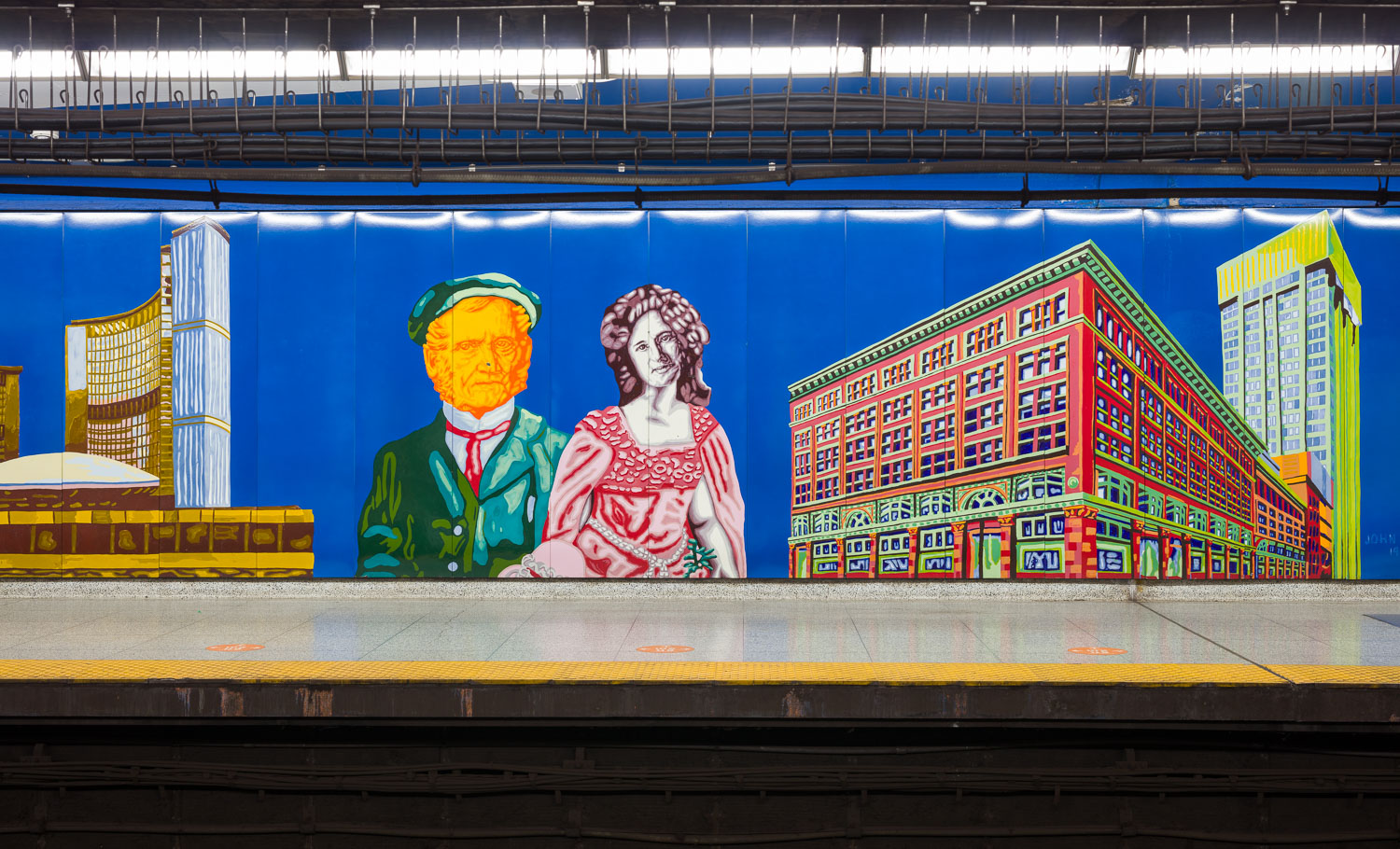
- Enamelled steel
- 1980
- Queen Station, Toronto
About the artwork
Queen Station contains a painted mural by self-taught Canadian John Boyle at the platform level titled Our Nell. Featuring depictions of Nellie McClung, William Lyon Mackenzie, as well as the former Simpson’s and Eaton’s department stores, Boyle’s work was known for his use of subjects drawn from his own specific life experience and from Canadian history. He was a part of the London Regional art movement.
Nellie McClung, women’s rights activist and one of the Valiant Five who successfully petitioned to have women recognized as “persons” by the Dominion government in 1927. The male figure is that of William Lyon Mackenzie, member of the Upper Canada Legislative Assembly 1827-1834; Toronto’s first lord mayor 1834; founder/publisher of the reform newspaper, The Colonial Advocate and leader, in Upper Canada of the Patriots’ Rebellion of 1837.
About the artist
John Boyle RCA is a self-taught award-winning Canadian painter, activist, curator and writer known for his use of subjects drawn from his own specific life experience and from Canadian history. He was a part of the London Regional art movement.
Boyle’s intricate and colourful paintings, dealing mainly with socio-political figures and elements of Canadian landscape, place him firmly within the realm of the Canadian response to the 1960s-era Pop phenomenon.
Boyle lived most of his life in the small town of London, Ontario. After studying at the London Teachers’ College and the University of Western Ontario, he moved to St. Catharine’s in 1962, where he worked intermittently as an elementary school teacher then, from 1968 on, as a professional artist. He also lived for a while in Elsinore, a small hamlet near Owen Sound and now resides in Peterborough.
Boyle initially intended to become a writer, but after seeing an exhibition of the work of Vincent Van Gogh in Detroit in 1962, he decided to concentrate on painting. Largely self-taught, he fully committed to his art, and his unique approach quickly began to garner interest. The artist is one of the few since the early twentieth century to focus on the Canadian socio-political figure outside of the realm of portraiture (Lakeside Park, 1970). Boyle is also noted for his emulation of the colour profile of screen-printing by omitting half-tones from his palette. This gives his paintings a dramatic intensity that reinforces the importance of the presented figures.
Boyle, deeply passionate about artist’s rights, spearheaded the foundation of the Niagara Artist’s Company in 1970 and was the founding spokesperson for CARO, the Canadian Artists’ Representation Ontario, the following year. The artist, whose paintings can be found in major collections across the country, was elected to the Royal Canadian Academy in 1975, received Canada Council B Grants in 1971, 1973 and 1979, and a Canada Council A Grant in 1987.
Fun facts
- People have often complained about the mural and in 2013 a woman named Frances Campbell advocated for its removal. And even though the mural looks like “potato-face people,” Frances should know the deeper meaning of this art piece. Indeed, the mural depicts Nellie McClung, a women’s rights activist and one of the Valiant Five who successfully petitioned to have women recognized as “persons” by the Dominion government in 1927.
Engagement questions
- Would you like as a citizen to be even more included within the community outreach and public engagement process in order to submit your personal thoughts over public art commissions?
- As long as art exists, it will always raise some approval as well as some disapproval: How can we deal with subversive concepts and ideas?
The Ring
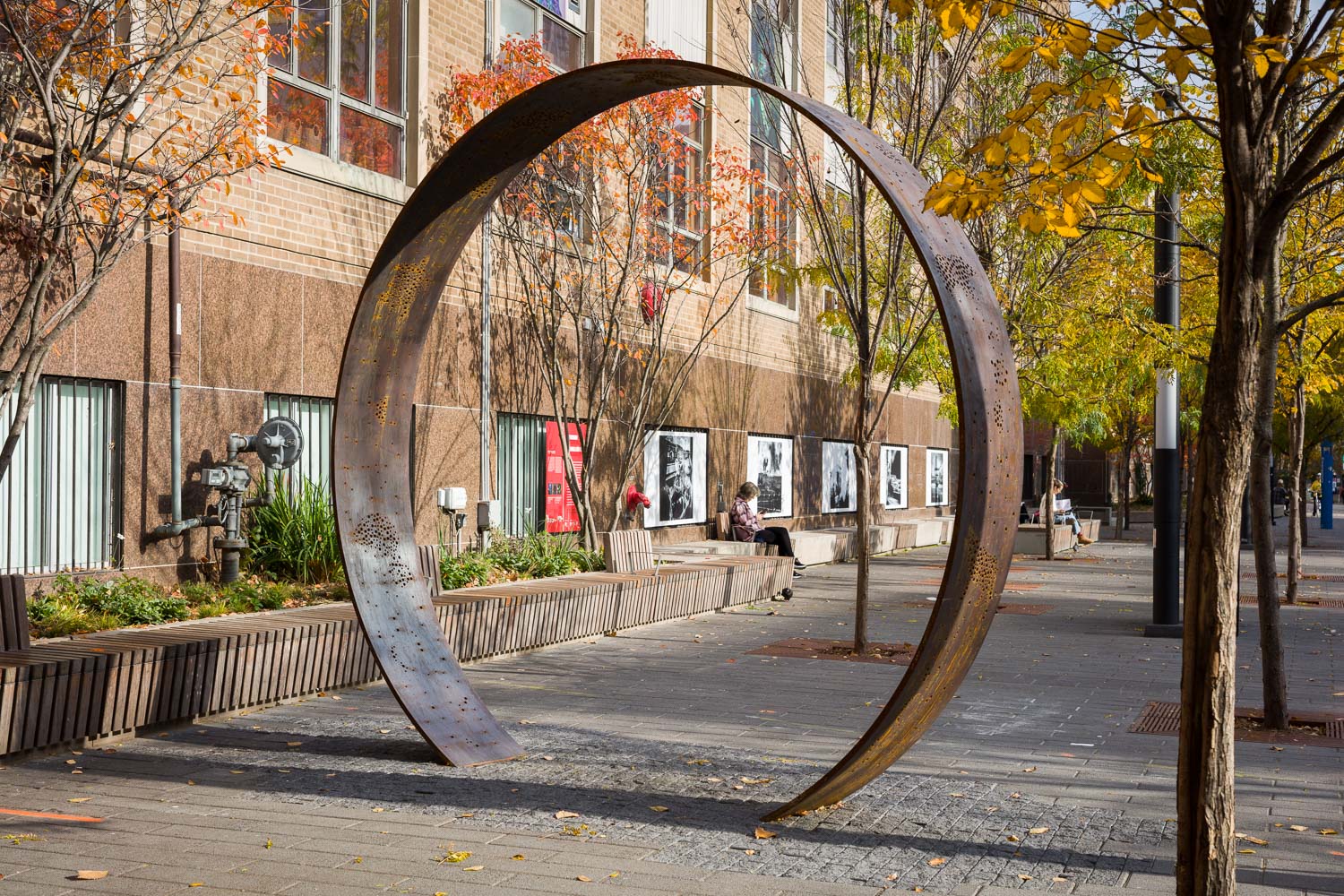
- Corten weathering steel
- 2021
- Ryerson University (east of the Gould Street and Nelson Mandela Walk intersection), Toronto
About the artwork
A large-scale public artwork colloquially known as The Ring was installed on campus in September 2021, honouring the Dish With One Spoon Territory, the land on which the university is built. Designed by Matthew Hickey and Jacqueline Daniel of Two Row Architect, the three-metre tall steel sculpture is located east of the Gould Street and Nelson Mandela Walk intersection.
The sculpture emerged from the thoughtful and ongoing work of the university’s Truth and Reconciliation Strategic Working Group in collaboration with members of Ryerson’s Indigenous community.
The Ring’s graphics, made by small perforations, incorporate the Seven Grandparent teachings and their animal symbols: Humility, Courage, Honesty, Wisdom, Truth, Respect and Love. Surrounded by stars and the constellation Pleiades, these pictographs also depict the lunar moon phases. The Ring is oriented with the cardinal directions (North, South, East and West) so that the pathway through its opening faces east, representing creation and new beginnings; and west, representing knowledge and wisdom.
Manufactured by Mariani Metal Fabricators, The Ring is made of Corten weathering steel, a type of material that is less processed and more likely to change with its environmental conditions; its exterior has been left untreated deliberately to allow the weathering process to continue.
The installation of such a prominent and permanent art piece on campus is one of many ways the university is working to implement recommendations from its 2018 Truth and Reconciliation Report, which includes the important practice of acknowledging the traditional territory and presence of Indigenous peoples on this land.
About the artist
Matthew Hickey is Mohawk from the Six Nations First Nation and is a licensed architect with 12 years of experience working in an on-reserve architecture firm. He received his Masters of Architecture from the University of Calgary and his Bachelor of Design from Ontario College of Art and Design, winning both the Alberta Association of Architects Presidents Medal and the Medal for Best Thesis, respectively.
Hickey’s focus is on regenerative design – encompassing ecological, cultural, and economic principles. His research includes Indigenous history and the adaptation of traditional sustainable technologies to the modern North American climate. He currently instructs at OCAD U, for the OAA and the Canada Green Building Council.
Jacqueline Daniel is an intern architect at Two Row Architect. She is a graduate of University of Michigan’s master of architecture program and holds a BA in architecture from the University of Toronto.
Two Row Architect is focused on guiding the realignment of mainstream ways of thinking on their journey towards Indigenous ways of knowing, being, design and architecture. The steel sculpture is one of a series of public art pieces at the university that will come to fruition throughout 2022.
Fun facts
- The story of The Ring was featured on Ryerson’s University’s The Forefront (season 2, episode 2), a podcast that showcases how Ryerson is tackling the big issues facing Canadians through bold research, innovation, and collaboration. The episode is called “How art can heal.”
- This year, the university is taking part in the City of Toronto Year of Public Art initiative, with a series of installments and exhibits. The Ring is one of the installments and is in honour of The Dish With One Spoon Territory, the land on which the university is built.
Engagement questions
- How can public artworks create a powerful dialogue towards the reconciliation process?
- How can art in the public realm best represent Indigenous communities and highlight their cultures and identities?
